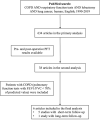Outcomes of lobectomy on pulmonary function for early stage non-small cell lung cancer (NSCLC) patients with chronic obstructive pulmonary disease (COPD)
- PMID: 32374491
- PMCID: PMC7592038
- DOI: 10.1111/1759-7714.13445
Outcomes of lobectomy on pulmonary function for early stage non-small cell lung cancer (NSCLC) patients with chronic obstructive pulmonary disease (COPD)
Abstract
Background: Lung cancer is the first cause of cancer mortality worldwide. Chronic obstructive pulmonary disease (COPD) is an independent risk factor for lung cancer. An epidemiological survey discovered that the presence of COPD increases the risk of lung cancer by 4.5-fold. Lobectomy is considered to be the standard surgical method for early stage non-small cell lung cancer (NSCLC). However, the influence of lobectomy on the loss of pulmonary function has not been fully investigated in NSCLC patients with COPD.
Methods: We searched the PubMed database using the following strategies: COPD and pulmonary function test (MeSH term) and lobectomy (MeSH term) from 01 January 1990 to 01 January 2019. We selected the articles of patients with COPD. A total of six studies, including 195 patients with COPD, provided lung function values before and after surgery.
Results: Five out of six studies focused on the short-term change of pulmonary function (within 3-6 months) after lobectomy, and the average loss of FEV1 was 0.11 L (range: -0.33-0.09 L). One study investigated the long-term change of pulmonary function (within 1-2 years) after lobectomy, and the average loss of FEV1 was 0.15 L (range: -0.29-0.05 L).
Conclusions: A short-term (3-6 months) loss of pulmonary function after operation is acceptable for lung cancer patients with COPD. However, there may be a high risk of postoperative complications in NSCLC patients with COPD. Therefore, surgical treatment needs to be carefully considered for these patients.
Keywords: COPD; lobectomy; non-small cell lung cancer; pulmonary function.
© 2020 The Authors. Thoracic Cancer published by China Lung Oncology Group and John Wiley & Sons Australia, Ltd.
Figures


 baseline value and
baseline value and  short‐term follow‐up). (b) The long‐term changes in FEV1. The study had two groups according to the difference value of preoperative FEV1 (
short‐term follow‐up). (b) The long‐term changes in FEV1. The study had two groups according to the difference value of preoperative FEV1 ( baseline value and
baseline value and  long‐term follow‐up).
long‐term follow‐up).References
-
- Sekine Y, Kesler KA, Behnia M, Brooks‐Brunn J, Sekine E, Brown JW. COPD may increase the incidence of refractory supraventricular arrhythmias following pulmonary resection for non‐small cell lung cancer. Chest 2001; 120 (6): 1783–90. - PubMed
-
- Abal Arca J, Parente Lamelas I, Almazán Ortega R, Blanco Pérez J, Toubes Navarro ME, Marcos VP. Lung cancer and COPD: A common combination. Arch Bronconeumol 2009; 45 (10): 502–7. - PubMed
-
- Lin TH, Chen SI, Su YC, Lin MC, Lin HJ, Huang ST. Conventional western treatment combined with Chinese herbal medicine alleviates the progressive risk of lung cancer in patients with chronic obstructive pulmonary disease: A nationwide retrospective cohort study. Front Pharmacol 2019; 10: 987. - PMC - PubMed
-
- Licker MJ, Widikker I, Robert J e a. Operative mortality and respiratory complications after lung resection for cancer: Impact of chronic obstructive pulmonary disease and time trends. Ann Thorac Surg 2006; 81 (5): 1830–7. - PubMed
Publication types
MeSH terms
Grants and funding
LinkOut - more resources
Full Text Sources
Medical

